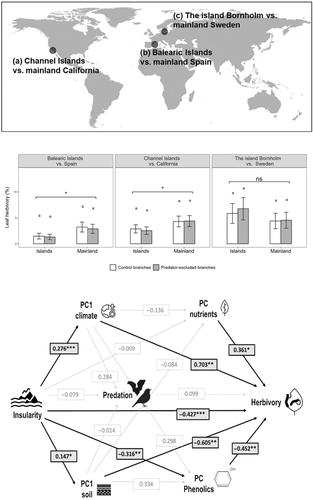Our official English website, www.x-mol.net, welcomes your
feedback! (Note: you will need to create a separate account there.)
Testing the contribution of vertebrate predators and leaf traits to mainland–island differences in insect herbivory on oaks
Journal of Ecology ( IF 5.3 ) Pub Date : 2024-11-06 , DOI: 10.1111/1365-2745.14444 Carla Vázquez‐González, Luis Abdala‐Roberts, Beatriz Lago‐Núñez, Lydia S. Dean, Miquel Capó, Raúl de la Mata, Ayco J. M. Tack, Johan A. Stenberg, Felisa Covelo, Ana Cao, Joana Cursach, Ana Hernández‐Serrano, Finn Hansen, Kailen A. Mooney, Xoaquín Moreira
Ecological theory predicts that herbivory should be weaker on islands than on mainland based on the assumption that islands have lower herbivore abundance and diversity. However, empirical tests of this prediction are rare, especially for insect herbivores, and those few tests often fail to address the mechanisms behind island–mainland divergence in herbivory. In particular, past studies have not addressed the relative contribution of top‐down (i.e. predator‐driven) and bottom‐up (i.e. plant‐driven) factors to these dynamics. To address this, we experimentally excluded insectivorous vertebrate predators (e.g. birds, bats) and measured leaf traits associated with herbivory in 52 populations of 12 oak (Quercus ) species in three island–mainland sites: The Channel Islands of California vs. mainland California, Balearic Islands vs. mainland Spain, and the island Bornholm vs. mainland Sweden (N = 204 trees). In each site, at the end of the growing season, we measured leaf damage by insect herbivores on control vs. predator‐excluded branches and measured leaf traits, namely: phenolic compounds, specific leaf area, and nitrogen and phosphorous content. In addition, we obtained climatic and soil data for island and mainland populations using global databases. Specifically, we tested for island–mainland differences in herbivory, and whether differences in vertebrate predator effects or leaf traits between islands and mainland contributed to explaining the observed herbivory patterns. Supporting predictions, herbivory was lower on islands than on mainland, but only in the case of Mediterranean sites (California and Spain). We found no evidence for vertebrate predator effects on herbivory on either islands or mainland in any study site. In addition, while insularity affected leaf traits in some of the study sites (Sweden‐Bornholm and California), these effects were seemingly unrelated to differences in herbivory. Synthesis . Our results suggest that vertebrate predation and the studied leaf traits did not contribute to island–mainland variation patterns in herbivory, calling for more nuanced and comprehensive investigations of predator and plant trait effects, including measurements of other plant traits and assessments of predation by different groups of natural enemies.
中文翻译:

测试脊椎动物捕食者和叶子性状对橡树昆虫食草性大陆-岛屿差异的贡献
生态学理论预测岛屿上的食草动物应该比大陆上的食草性更弱,这是基于岛屿食草动物数量和多样性较低的假设。然而,对这一预测的实证检验很少见,尤其是对于昆虫食草动物,而且这些少数测试往往无法解决食草动物岛屿-大陆分化背后的机制。特别是,过去的研究没有解决自上而下(即捕食者驱动)和自下而上(即植物驱动)因素对这些动态的相对贡献。为了解决这个问题,我们实验排除了食虫脊椎动物捕食者(例如鸟类、蝙蝠),并测量了三个岛屿-大陆地点的 12 种橡树 (Quercus) 物种的 52 个种群中与食草相关的叶子特性:加利福尼亚海峡群岛与加利福尼亚大陆、巴利阿里群岛与西班牙大陆以及博恩霍尔姆岛与瑞典大陆(N = 204 棵树)。在每个地点,在生长季节结束时,我们测量了昆虫食草动物对对照树枝与捕食者排除的树枝的叶片损伤,并测量了叶片性状,即:酚类化合物、比叶面积以及氮和磷含量。此外,我们还使用全球数据库获得了岛屿和大陆种群的气候和土壤数据。具体来说,我们测试了岛屿-大陆食草动物的差异,以及岛屿和大陆之间脊椎动物捕食者效应或叶子特征的差异是否有助于解释观察到的食草模式。支持预测的是,岛屿上的食草性低于大陆,但仅限于地中海地区(加利福尼亚和西班牙)。在任何研究地点,我们都没有发现脊椎动物捕食者对岛屿或大陆食草动物影响的证据。 此外,虽然岛隔影响了一些研究地点(瑞典-博恩霍尔姆岛和加利福尼亚)的叶子性状,但这些影响似乎与食草动物的差异无关。合成。我们的结果表明,脊椎动物的捕食和所研究的叶子性状对食草动物的岛屿-大陆变异模式没有贡献,需要对捕食者和植物性状的影响进行更细致和全面的调查,包括其他植物性状的测量和不同天敌群体的捕食评估。
更新日期:2024-11-06
Journal of Ecology ( IF 5.3 ) Pub Date : 2024-11-06 , DOI: 10.1111/1365-2745.14444 Carla Vázquez‐González, Luis Abdala‐Roberts, Beatriz Lago‐Núñez, Lydia S. Dean, Miquel Capó, Raúl de la Mata, Ayco J. M. Tack, Johan A. Stenberg, Felisa Covelo, Ana Cao, Joana Cursach, Ana Hernández‐Serrano, Finn Hansen, Kailen A. Mooney, Xoaquín Moreira

|
中文翻译:

测试脊椎动物捕食者和叶子性状对橡树昆虫食草性大陆-岛屿差异的贡献
生态学理论预测岛屿上的食草动物应该比大陆上的食草性更弱,这是基于岛屿食草动物数量和多样性较低的假设。然而,对这一预测的实证检验很少见,尤其是对于昆虫食草动物,而且这些少数测试往往无法解决食草动物岛屿-大陆分化背后的机制。特别是,过去的研究没有解决自上而下(即捕食者驱动)和自下而上(即植物驱动)因素对这些动态的相对贡献。为了解决这个问题,我们实验排除了食虫脊椎动物捕食者(例如鸟类、蝙蝠),并测量了三个岛屿-大陆地点的 12 种橡树 (Quercus) 物种的 52 个种群中与食草相关的叶子特性:加利福尼亚海峡群岛与加利福尼亚大陆、巴利阿里群岛与西班牙大陆以及博恩霍尔姆岛与瑞典大陆(N = 204 棵树)。在每个地点,在生长季节结束时,我们测量了昆虫食草动物对对照树枝与捕食者排除的树枝的叶片损伤,并测量了叶片性状,即:酚类化合物、比叶面积以及氮和磷含量。此外,我们还使用全球数据库获得了岛屿和大陆种群的气候和土壤数据。具体来说,我们测试了岛屿-大陆食草动物的差异,以及岛屿和大陆之间脊椎动物捕食者效应或叶子特征的差异是否有助于解释观察到的食草模式。支持预测的是,岛屿上的食草性低于大陆,但仅限于地中海地区(加利福尼亚和西班牙)。在任何研究地点,我们都没有发现脊椎动物捕食者对岛屿或大陆食草动物影响的证据。 此外,虽然岛隔影响了一些研究地点(瑞典-博恩霍尔姆岛和加利福尼亚)的叶子性状,但这些影响似乎与食草动物的差异无关。合成。我们的结果表明,脊椎动物的捕食和所研究的叶子性状对食草动物的岛屿-大陆变异模式没有贡献,需要对捕食者和植物性状的影响进行更细致和全面的调查,包括其他植物性状的测量和不同天敌群体的捕食评估。


















































 京公网安备 11010802027423号
京公网安备 11010802027423号